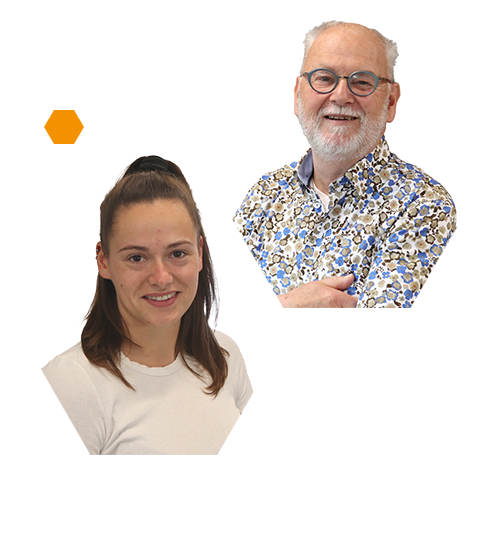Improvement programs are part of Aeronamic’s DNA
Fred Hospers & Madelein van der Jeugd - Improvement Manager & Improvement Board Member

Continuous improvement. That might sound logical, like something every organization wants to do in its own way. But for Aeronamic, continuous improvement really is logical. To continuously optimize our processes is not only what customers ask of us – it’s what we ask of ourselves. Continuous improvement is at the heart of our right to exist, improving our productivity and quality. But what does this mean in concrete terms? In this blog, we talk to Improvement Manager Fred Hospers and Improvement Board Member Madelein van der Jeugd about our various improvement programs, particularly our digital factory and the KATA method.
Fred: “Improvement programs are part of Aeronamic’s DNA, deeply rooted in all layers of our organization. This starts with the members of our management team, each of whom believes that improvement programs have an immediate effect. But this is also true of the rest of the team.” You can see this reflected in the number of employees who are certified as a Six Sigma ‘Black Belt’. As Madelein explains: “Black Belts play an important role in improving processes and people’s performance in an organization. We have a total of eleven Black Belts at Aeronamic, including me, which is quite a high proportion when you consider that we have 140 employees.” Besides, the “improvement board” mirrors Aeronamic’s ambitions. “This is an in-house team of experts who are involved in all kinds of improvement projects,” Madelein continues. “This means small and short-term projects as well as big and long-term projects. Each project aims to improve the productivity and/or quality of our processes, and many of them have already proved highly successful.”

Our digital factory
“The ‘digital factory’ is an example of a major project which includes all kinds of small sub-projects,” says Fred. “Various departments are working on this. Our ultimate goal is to have a paperless factory, but that’s not something you can achieve in a day, of course. That said, we’ve already made great strides in that direction, such as the introduction of digital work instructions and digital maintenance checklists.” Right now, Aeronamic is developing various apps which aim to improve processes, such as the “shop floor app”. Madelein: “We develop apps completely in-house. With the shop floor app, for example, employees can visualize their own workplace, book their hours, control production orders, manage KPIs, etc. Apps like this mean that we can have more control over our processes, as well as making those processes clearer for our employees, resulting in higher work efficiency.”
KATA method
Fred: “Another project our improvement board is currently working on is the implementation of the KATA method. This is a pragmatic form of project management that Aeronamic applies in new activities, which reduces the lead time of a new product to series production. This enables us to shorten the time to market. The lead time can even be reduced from 18 to 6 months!”
Madelein explains the benefits: “In the past, the various disciplines involved in a project would tackle their own roles separately. However, with the KATA method, all disciplines form a team right from the beginning. This can give rise to different ideas and perspectives, which we then develop and test so that we can clarify any potential problems before the start of production. Doing it this way gives us insights and problem analyses much faster, saving us lots of time.” Aeronamic is testing this method in a variety of projects. Fred: “Especially when it comes to our solutions for Advanced Air Mobility – part of our Mission Zero – the KATA method is proving highly beneficial. With one of our projects, we managed to carry out the first experiment within a week, instead of months. You can imagine what a difference that makes!”
Never done improving
Madeleine argues that improvement is a never-ending story. “It’s an ongoing process during which we are constantly learning, improving and optimizing the way we improve.” Fred agrees. “I love this job so much that I will continue to work with Aeronamic even after my retirement in August. There’s lots of work to be done. In addition to the improvement processes that we carry out under our customers’ license, we are also developing our own products. To achieve this, we are using all the experience we have accumulated while manufacturing products under license.” In the end, improvement requires patience. Madelein: “As with everything in our industry, it’s all about our long-term vision, and it’s great that the entire organization is on board with it. We firmly believe that all improvement programs pay for themselves.” Fred concludes: “Improvement is necessary for a company to be profitable. And it is because we are profitable that we can continue investing in improvement programs. It’s a cycle of success!
How do you handle improvement programs in your business?